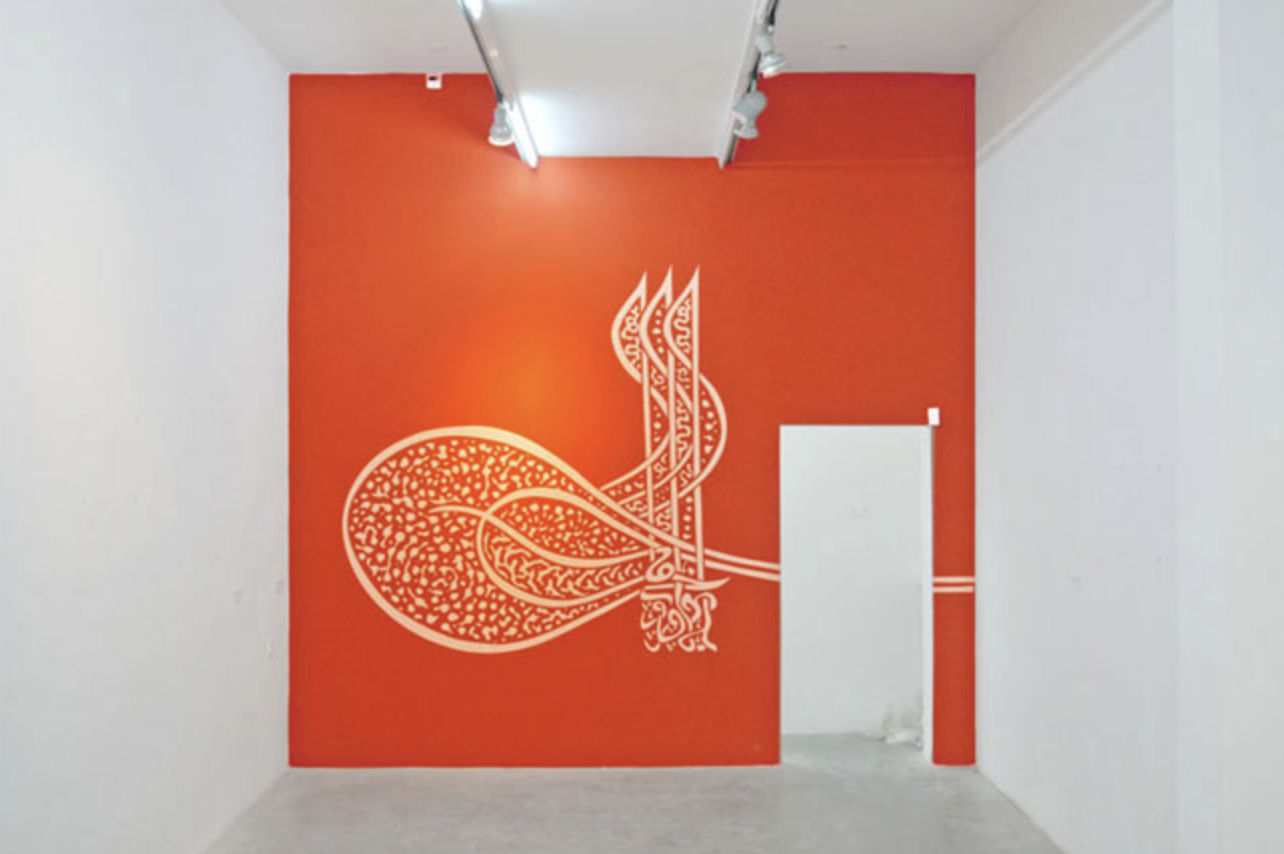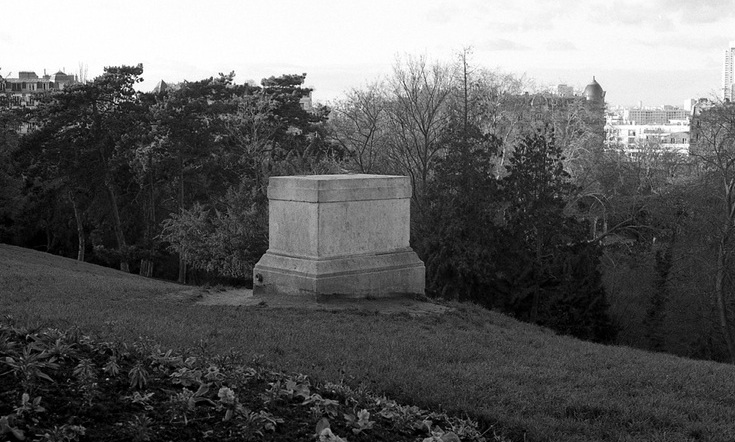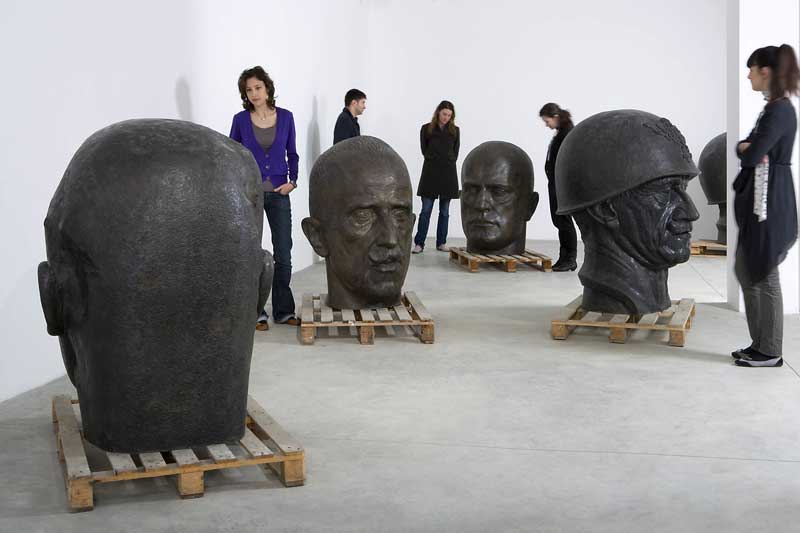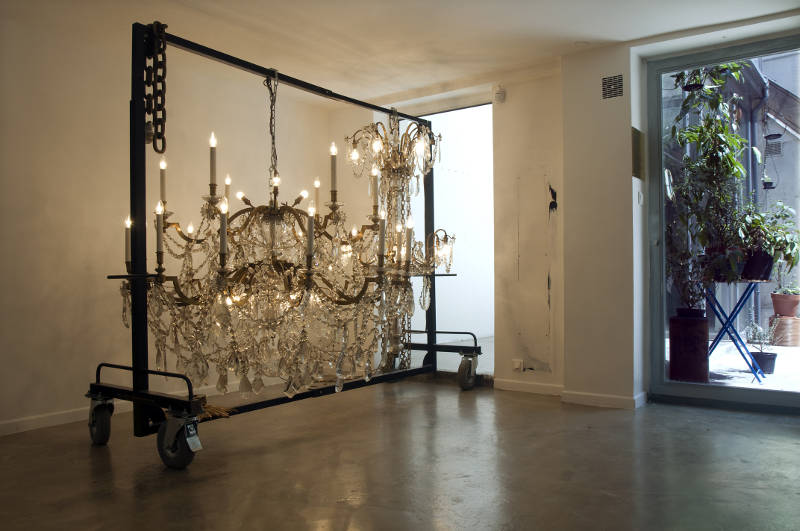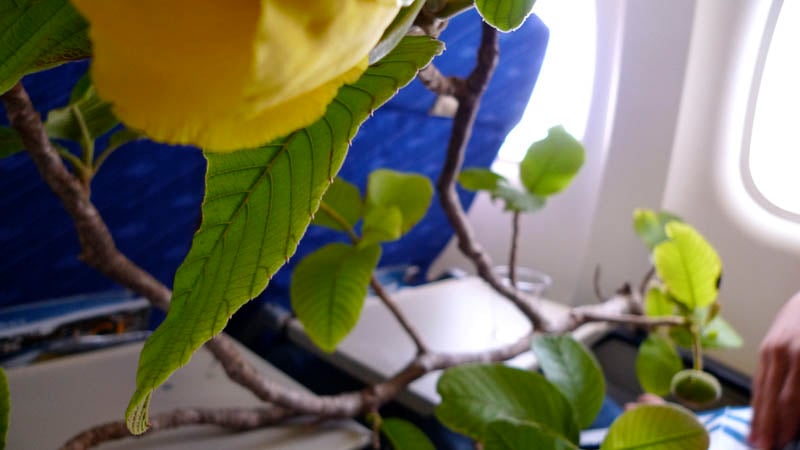
© » KADIST
Victor & Sergiy Kochetov
Having a press card allowed Viktor Kochetov to photograph freely in public places, access to which was strictly regulated for amateurs. Seeking a way to transgress the reportage canon, the Kochetovs employed a method of taking images of large gatherings that emphasize the structure and “patterns” of the imaginary collective body. His 1978 photo of women sorting corn, titled Working women, builders of communism, are sorting corn… , is organized on this principle: the scarfs on the workers’ heads are perceived as an element of uniform, which creates a visual rhythm.

© » KADIST
Ali Yass
Drawing & Print (Drawing & Print)
Now; 1992 is Ali Yass’s attempt to remake his childhood drawings, which were lost after he was forced to leave Iraq following the 2003 US occupation. The drawings are chimeric compositions of animated limbs, animal, human, and machine, that seem to hurl in all directions and mediums, unified as colorful figurations posed against blank backgrounds, rendering the curious characters suspended in time. This suspension materializes the artist’s view on violence and temporality, on which he has claimed: “I will not talk about war because it is from the past.

© » KADIST
Victor & Sergiy Kochetov
Ukraine-Russia / Volleyball by Viktor and Sergiy Kochetov features a concrete monument of women volleyball players before the railway station in the village of Vodyanoye, Kharkiv region. It’s a typical Soviet sculptural composition, thousands of which were casted in the USSR during this period. Many can still be found all over post-Soviet territories, leading to regular debates on the destiny of this visual heritage in Ukraine.

© » KADIST
Sung Tieu
Modelled and rendered in 3D, Moving Target Shadow Detection by Sung Tieu reconstructs the entire interior of the Hotel Nacional de Cuba in Havana, the site of the first-known instance of a supposed sonic attack, which collectively became known as ‘Havana Syndrome’. First reported by CIA staff in the Cuban capital in 2016, the syndrome includes a range of unexplained disorders ranging from nausea, fatigue and memory loss to brain injuries resembling concussions. In Tieu’s film, CCTV camera footage and images taken by a nano drone lead from the hotel’s lobby to an occupied hotel room, where the viewer is confronted with classified documents and news reportages of the recent Havana Syndrome attacks around the world.

© » KADIST
Wendy Cabrera Rubio
Victory Through Air Power III (1943) by Wendy Cabrera Rubio is part of a series of quilted maps that reproduce different scenes from the eponymous film. Victory Through Air Power the film is an animated history of aviation produced by Walt Disney, and likely one of the first educational and documentary films using animation. Disney’s political agenda, specifically towards Latin America, has played an important role in Cabrera’s practice.
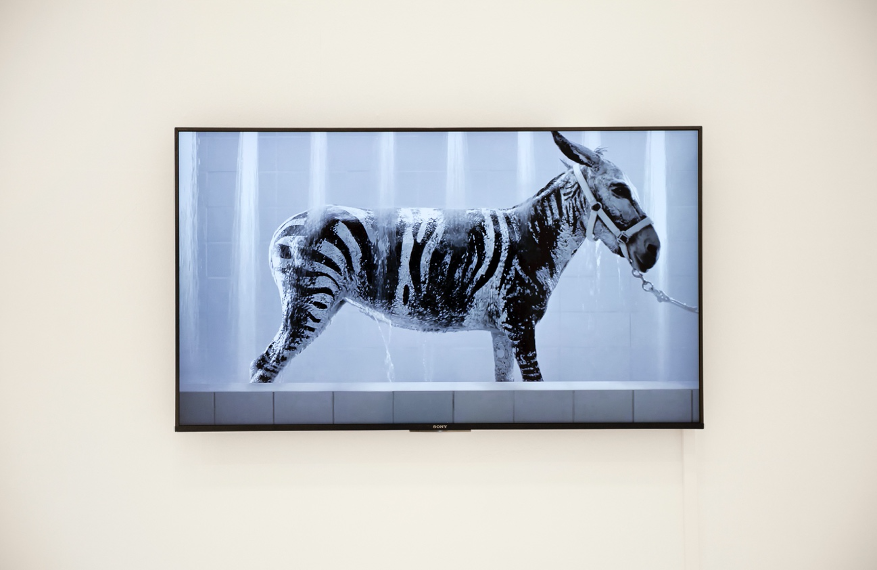
© » KADIST
Sharif Waked
Bath Time by Sharif Waked is a short video based on the tragi-comic outcome of the Israeli Blockade and the wars in Gaza. The story tells about how, after a war and the ongoing economic pressure, the Gaza Zoo lost several of their animals, and decided that they could paint a donkey so that it could pose as a zebra. The video imagines the donkey in the shower after a shift impersonating a zebra at the Gaza Zoo, as the hot water slowly washes its faux stripes away.

© » KADIST
Joaquín Segura
Pyre , an installation by Mexico City-based artist Joaquín Segura, addresses corruption, impunity, and the role that failed governments play in the normalization of violence. The work references mass disappearances at the hands of corrupt armed forces and paramilitary groups that have taken place in Mexico since the 1960s and significantly escalated over the last decade due to the War on Drugs. While the piece may be installed any number of ways, it is marked by the precision of its material content: 71 liters of gasoline, 23 used car tires, and 760 kilograms of wood.

© » KADIST
Dana Kavelina
Letter to a Turtledove by Dana Kavelina is a short film based on a poem written by the artist. Delivered as a monologue and presented with subtitles, the poem encapsulates the traumas, grievances, horrors, dreams, and hallucinations that have descended upon Ukraine’s Donbass region since its invasion by Russia in 2014. Appropriating amateur footage shot during the war in the Donbass region, Kavelina’s film weaves sound and image into a poignant tapestry that considers the absurdity of war.

© » KADIST
Victor & Sergiy Kochetov
According to Viktor Kochetov, Meeting with the awaited guest / Yellow Bows is the first hand-colored print he ever made. Although this might well be a part of the artist’s mythology, this image perfectly demonstrates the methodology the Kochetovs used in their work. The snapshot itself was created during a journalistic assignment to document the meeting between a WWII veteran and school children in the Kharkiv region.

© » KADIST
Pratchaya Phinthong
Pratchaya Phinthong’s work has explored the mineral and karmic economies of Laos, a country that shares language, beliefs, and a long border with his own native region of Isaan (Northeast Thailand). The most bombed nation on earth, Laos still bears the physical and mental scars of the U. S. military’s epic aerial offensive, launched largely from bases in Isaan, during the Second Indochina War. Between 1964 and 1973 the US dropped an estimated 250 million cluster bombs on Laos.

© » KADIST
Pratchaya Phinthong
Pratchaya Phinthong’s work has explored the mineral and karmic economies of Laos, a country that shares language, beliefs, and a long border with his own native region of Isaan (Northeast Thailand). The most bombed nation on earth, Laos still bears the physical and mental scars of the U. S. military’s epic aerial offensive, launched largely from bases in Isaan, during the Second Indochina War. Between 1964 and 1973 the US dropped an estimated 250 million cluster bombs on Laos.

© » KADIST
Aziz Hazara
Youthfulness and gestures of play are central to Aziz Hazara’s practice. The artist uses these mechanisms as a lens to give pause to the behaviours of children as foreboding reflections of the enduring and all-pervasive effects of conflict and war. In the short video Rehearsal the artist documents two young Afghan boys imitating the guttural rattling of an automatic rifle, play-shooting in the field in front of them, and swivelling as if to suggest the gun is mounted.

© » KADIST
Nikita Kadan
Drawing & Print (Drawing & Print)
East of Ukraine became a place of armed conflict with Russia-backed separatists, who proclaimed parts of (the) Donetsk and Lughansk oblast (administrative region in Ukrainian) to be ‘People’s republics’. This region, in conflict since spring 2014, is where most of the charcoal is extracted. It is with this same coal that artist Nikita Kadan realizes this drawing in 2018, representing a field on which is juxtaposed a small photograph.

© » KADIST
Erbossyn Meldibekov
Game (Six Pieces) by Erbossyn Meldibekov is inspired by the popular Rubik’s cube puzzle and is composed of three colors (red, green and white) instead of six, referencing the colors of the Afghan flag. The work provides a revisionist interpretation of the legacy of The Great Game (the original 19th-century standoff between Russian and British empires over Afghanistan), and Afghanistan’s position as a centerpiece of the longstanding War on Terror, (the military campaign led by the United States and their allies against organizations and regimes they identified as terrorists after 9/11). Game (Six Pieces) mobilizes dark humor and irony to illustrate the complex and unstable relationships between communism, Islam, and American and British imperialism.

© » KADIST
Phan Quang
Phan Quang’s portrait series Re/cover grapples with a lesser-known history in Vietnam. After World War II, many Japanese soldiers who fought in Vietnam stayed in the country. They married Vietnamese women, had children, and lived in the country until Japan recalled them home.

© » KADIST
Yuichiro Tamura
The installation Hey Daddy, Hey Brother comprises a series of “Sukajan” jackets, which Tamura collected over a period of several years. They were a popular souvenir among the US military stations in postwar Japan during the Korean War (1950-1953). With origins rooted in military occupation of in the East Asia region, the jackets fuse the American “bomber,” or baseball jacket, with traditional hand-stitched designs of Japanese iconography, including dragons, tigers, Mt.

© » KADIST
Nikita Kadan
Drawing & Print (Drawing & Print)
Ukraine is under tension due to the politics of President lanoukovitch since 2010. Numerous passive demonstrations against the government have led to numerous police repression of the protestors. The demonstration ‘Euromaïdan’ in 2013 is a perfect example.

© » KADIST
Clemens von Wedemeyer
Clemens von Wedemeyer has imagined a trip back in time at Breitenau. Starting with events that happened there from 1933 to 1945, the German artist has composed three stories that reach the years of the women’s reformatory, in the 1970s, with a different protagonist for each era. A work that attempts to bring out the “pathology” of the site, as the artist tells Bert Rebhandl, and at the same time its “unforgettable” status as a black hole in the history of Germany, that sucked up innocent lives for almost a century.

© » KADIST
Tala Madani
Madani works on a small scale and a large scale. This work is from a series of small paintings called Dazzle Men that take as their starting point the Dazzle patterns used by artists to camouflage ships during the First World War. Dazzle camouflage was designed to confuse the aim of U boat commanders.

© » KADIST
Nguyen Thai Tuan
In the “Black Paintings” series, although the human body is only suggested, it plays an important role. Some body parts are absent, mostly the faces which are usually an affirmation of the individual. The characters recall ghosts testifying as to the traumas of war.

© » KADIST
Lu Pingyuan
Masterpiece in the Water by Lu Pingyuan tells the story of an impatient collector who is killed by an artist. This murder becomes an artwork in of itself as the story within the story sheds light on the psychological anxieties faced by soldiers during war time, the family bond, and the paranormal. This playful, yet violent, story explores the amusing similarity between supernatural events and the creation of artistic ideas, while reflecting on the complex relationships that exist within the art world.

© » KADIST
Mounira Al Solh
In 2011, Mounira Al Solh began a series of drawings that documented her meetings and conversations with displaced Syrian refugees in Lebanon and various European countries. The oral histories she collected are very different from those told in administrative interviews or police interviews. My specialty was to make a peasants’ haircut, but they obliged me work till midnight often (2017) is part of a series of embroideries that speaks to how personal stories in this political context create collective history.

© » KADIST
Vandy Rattana
Vandy Rattana’s Bomb Ponds series was made following a transformative encounter with the craters left over from 2,756,941 tons of bombs dropped by U. S. forces during the Vietnam War between 1964 and 1973. Dissatisfied with the level of documentation on the bombing and its repercussions, the artist began to study the historiography of his country. He travelled to the ten most severely bombed provinces, engaging villagers in locating and testifying to the existence of the craters, and how they are lived with today.

© » KADIST
Christine Rebet
In the Soldier’s Head evokes the traumas of war through the prism of the hallucinations of a soldier. Inspired by the artist’s father,a soldier in Algeria who then suffered from post-traumatic stress disorder,the video depicts the delusions flowing from a mind ravaged by violence: a vision grown from the inside out. Like a mirage amidst a blank, desert expanse, specters are conjured as the inanimate comes to life.

© » KADIST
Naufus Ramírez-Figueroa
Naufus Ramírez-Figueroa’s performance Illusion of Matter establishes a dream state through a composition of motifs that were drawn from the artist’s childhood memories. Ramírez-Figueroa recreated the components of the dream as giant props made out of polystyrene, and set in a colorful yellow and orange mise-en-scene. Throughout the performance, the props and set are activated and demolished by children under the artist’s direction.

© » KADIST
AES+F
The Last Riot was originally created for Venice Biennale in 2007. In reference to Baroque Painting tradition and Chiaroscuro, this video installation imagines a dystopian virtual world where bodies removed from conscience and emotion exist weightlessly in a cyber paradigm. Light, shadow and digital manipulation slate a post-apocalyptic world where young teens enact conflict as ritual.

© » KADIST
Allora & Calzadilla
Drawing & Print (Drawing & Print)
Intermission (Halloween Iraq IV) is a large print that depicts U. S. soldiers in Iraq celebrating Halloween. They ride donkeys—apparently playing polo—while wearing masks that simultaneously familiarize the soldiers, through the recognition of a common holiday, and distance them, through the obscuring of their faces. Its means of reproduction—a woodblock print—further amplifies the distance between the event and its presentation, as well as the engagement of the artists.

© » KADIST
Meiro Koizumi
Words by Meiro Koizumi: “The video installation work In the State of Amnesia is made with Mr. Nobuhiro Tanaka, who damaged his brain when he had an accident when he was 21. Since then he has been living with a memory disorder. I asked Mr. Tanaka to memorize a testimony of a Japanese soldier who served in the war in China during WWII.

© » KADIST
Ryan Villamael
Behold A City 4 extols the old grandeur of Manila, the nation’s storied capital – the complex nexus of heritage, modernity, and all sorts of compulsions, political or otherwise, that attempt to define it. This is not Manila whittled down to a scale model but a re-imagination of the city by Ryan Villamael in his ardor to approximate its complexity both as a physical, urban fact and an evolving concept. Behold A City 4 features an entirely new topography and arrangement.

© » KADIST
Tom Nicholson
Tom Nicholson’s Comparative Monument (Palestine) engages a peculiar Australian monumental tradition: war monuments that bear the name “Palestine”. Countless of these monuments were built immediately after World War 1 to commemorate the presence of Australian troops in Palestine. The Australian troops had entered Palestine in 1917 after fighting the Turks threatening the Suez Canal with the British, when the main focus was on the European fronts rather than on the Middle East campaign.
Victor & Sergiy Kochetov
Viktor Kochetov became engaged in photography in 1968 and was also a professional photographer in film and photo laboratories...
Nikita Kadan
Trained in large-scale painting, Nikita Kadan’s artistic practice encompasses installation, graphics, painting, wall drawing, and urban postering, sometimes in collaboration with architects, human rights activists, and sociologists...
Yee I-Lann
- location: Kuala Lumpur, Malaysia
- year born: 1971
- gender: female
- nationality: Malaysian
- home town: Sabah, Malaysia
James T. Hong
James T...
Pratchaya Phinthong
Pratchaya Phintong’s works often arise from the confrontation between different social, economic, or geographical systems...
Vandy Rattana
A self-taught photographer, Vandy Rattana has focused on challenging conditions in Cambodia, his home country, by documenting natural and manmade disasters...
Sharif Waked
Sharif Waked is a Palestinian artist who’s work enages with with Islamic culture and history, and its interaction with the Israeli occupation and hegemonic Jewish culture in Palestine...
Aslan Goisum
Chechen artist Aslan Goisum’s work engages with memories–collective and personal, political and cultural–to unearth clues about colonial realities, how they have been endured, and how they might be undone...
Walid Raad
Walid Raad is a Lebanese artist whose work investigates the way historical events of physical and psychological violence affect bodies, minds, culture, and memory...
Tala Madani
Madani’s paintings have a caricatural quality that suggest a satirical intention...
Yao Jui-Chung
- year born: 1969
- gender: male
- nationality: Taiwanese
- home town: Taipei, Taiwan
Nguyen Thai Tuan
Nguyen Thai Tuan was born in 1965, he studied at the school of Fine Arts of Hue where he studied propaganda art, which he got bored of very quickly...
Christine Rebet
Taking formal cues from the optical illusions and landscapes drawn in pre-cinematic entertainment, French artist Christine Rebet seeks to unveil the way these kinds of devices are mirrored in contemporary politics and media...
Mary Reid Kelley
Drawing from literature, plays, and historical events, Mary Reid Kelley makes rambunctious videos that explore the condition of women throughout history...
Meiro Koizumi
Meiro Koizumi is a Japanese video and performing artist, born in 1976...
Ali Yass
Ali Yass is a painter and filmmaker whose work entangles personal and collective memory in its psycho-affective interrogation of power...
Lu Pingyuan
Lu Pingyuan works with a variety of media such as texts, videos, installations, paintings, performances and other...
Sung Tieu
Sung Tieu’s artistic vocabulary explores the vast and evolving protection and control industries, still rooted in the logic of the Cold War, used to restrict and mould subjects in subsequently globalized capitalism...
Dana Kavelina
Dana Kavelina is an artist and activist who works with video, animation, painting, illustration, and text...
Wendy Cabrera Rubio
Wendy Cabrera Rubio is part of a generation of artists that has been invested in revisiting the history of Mexican arts and crafts with a multidisciplinary and pedagogical approach...
Erbossyn Meldibekov
Through drawing, installation, painting, photography, and video, Erbossyn Meldibekov’s practice examines architecture, monumentality, and value systems in the public domain...
Randa Maddah
Randa Maddah, was born 1983 in Majdal Shams, occupied Syrian Golan...
Tom Nicholson
Tom Nicholson is trained in drawing, a medium which he has used to think about the relationships between public actions and their traces, between propositions and monuments, and between writing and images...
Clemens von Wedemeyer
- location: Göttingen, Deutschland
- year born: 1974
- gender: male
- nationality: German
Ibro Hasanovic
Ibro Hasanovic is a film, video, photographic and installation artist currently based in Brussels, Belgium, concerned largely with the powers of individual and collective memory...
Maayan Amir and Ruti Sela
Maayan Amir and Ruti Sela, two young Israeli women artists work collaboratively or individually by project...
Vuth Lyno
Vuth Lyno’s artistic practice operates at a crucial intersection of contemporary Khmer culture...
Yuichiro Tamura
Yuichiro Tamura works in a wide range of media including video, photography, installation and performance...
Du Zhenjun
- location: Paris, France
- location: Shanghai, China
- year born: 1961
- gender: male
- nationality: Chinese
- home town: Shanghai, China
-
1970-1979
Victor & Sergiy Kochetov
1978Having a press card allowed Viktor Kochetov to photograph freely in public places, access to which was strictly regulated for amateurs...
-
1980-1989
Victor & Sergiy Kochetov
1982According to Viktor Kochetov, Meeting with the awaited guest / Yellow Bows is the first hand-colored print he ever made...
-
1990-1999
Victor & Sergiy Kochetov
1992Ukraine-Russia / Volleyball by Viktor and Sergiy Kochetov features a concrete monument of women volleyball players before the railway station in the village of Vodyanoye, Kharkiv region...
-
2000-2009
Maayan Amir and Ruti Sela
2003In Beyond Guilt the two artists create a portrait of our generation in three parts...
Harrell Fletcher
2005The American War , which takes its title from the Vietnamese term for what Americans call the Vietnam War, has toured the United States extensively with the goal of presenting a Vietnamese perspective of that history...
Nguyen Thai Tuan
2008In the “Black Paintings” series, although the human body is only suggested, it plays an important role...
Vandy Rattana
2009Vandy Rattana’s Bomb Ponds series was made following a transformative encounter with the craters left over from 2,756,941 tons of bombs dropped by U...
Szabolcs Kisspál
2009Lifesize Draft is the second of two sculptures on a similar theme, the first one being Utopia Battery, (2008)...
Walid Raad
Drawing & Print
2009(Drawing & Print) “The Lebanese wars of the past three decades affected Lebanon’s residents physically and psychologically: from the hundred thousand plus who were killed; to the two hundred thousand plus who were wounded; to the million plus who were displaced; to the even more who were psychologically traumatized...
-
2010-2019
Allora & Calzadilla
Drawing & Print
2010(Drawing & Print) Intermission (Halloween Iraq IV) is a large print that depicts U...
Mary Reid Kelley
2010Situated in German-occupied Belgium at the end of World War I, Y ou Make Me Iliad by Mary Reid Kelley focuses on the story of two...
Tomoko Yoneda
2010Yoneda’s Japanese House (2010) series of photographs depicts buildings constructed in Taiwan during the period of Japanese occupation, between 1895 and 1945...
Du Zhenjun
2010The Tower of Babel is an installation of large-format photographs that forces the audience to occupy a central position through its monumental scale...
Sharif Waked
2012Bath Time by Sharif Waked is a short video based on the tragi-comic outcome of the Israeli Blockade and the wars in Gaza...
Tom Nicholson
2012Tom Nicholson’s Comparative Monument (Palestine) engages a peculiar Australian monumental tradition: war monuments that bear the name “Palestine”...
James T. Hong
2012Taiwan WMD (Taiwan and Weapons of Mass Destruction) is part of a long-term research started in early 2010 on the history and aftermath effects of Japanese biological and chemical warfare in China during WWII, as well as the unknown history of Taiwan’s nuclear program...
Randa Maddah
2012A woman meticulously tidies up the room of a ruined house in the village of Ain Fit in the occupied Syrian Golan...
Phan Quang
2013Phan Quang’s portrait series Re/cover grapples with a lesser-known history in Vietnam...
Nikita Kadan
Drawing & Print
2013(Drawing & Print) Ukraine is under tension due to the politics of President lanoukovitch since 2010...
Nikita Kadan
Drawing & Print
2013(Drawing & Print) Ukraine is under tension due to the politics of President lanoukovitch since 2010...
Shay Arick
2013Part of a series of videos called LIFE, where Shay Arik videos that re-enact iconic journalistic photographs...
Yao Jui-Chung
2013Long Long Live (2013) takes the viewer to the setting of the Oasis Villa on Green Island, once a reform and re-education prison to house political prisoners during Taiwan’s martial law period...
Christine Rebet
2015In the Soldier’s Head evokes the traumas of war through the prism of the hallucinations of a soldier...
Naufus Ramírez-Figueroa
2015Naufus Ramírez-Figueroa’s performance Illusion of Matter establishes a dream state through a composition of motifs that were drawn from the artist’s childhood memories...
Meiro Koizumi
2015Words by Meiro Koizumi: “The video installation work In the State of Amnesia is made with Mr...
Aslan Goisum
2015The video work Volga by Aslan Goisum begins with a sweeping field caught under a misty, gray sky...
Ibro Hasanovic
2015Note on Multitude is a chilling black-and-white short movie recorded with a single camera in Prishtina, Kosovo, in 2015...
Joaquín Segura
2016Pyre , an installation by Mexico City-based artist Joaquín Segura, addresses corruption, impunity, and the role that failed governments play in the normalization of violence...
Lu Pingyuan
2016Masterpiece in the Water by Lu Pingyuan tells the story of an impatient collector who is killed by an artist...
Nohemí Pérez
Drawing & Print
2016(Drawing & Print) A rich and isolated region, El Catatumbo is located near the border with Venezuela...
Erbossyn Meldibekov
2017Game (Six Pieces) by Erbossyn Meldibekov is inspired by the popular Rubik’s cube puzzle and is composed of three colors (red, green and white) instead of six, referencing the colors of the Afghan flag...
Yuichiro Tamura
2017The installation Hey Daddy, Hey Brother comprises a series of “Sukajan” jackets, which Tamura collected over a period of several years...
Mounira Al Solh
2017In 2011, Mounira Al Solh began a series of drawings that documented her meetings and conversations with displaced Syrian refugees in Lebanon and various European countries...
Michael Rakowitz
2017The Ballad of Special Ops Cody by Michael Rakowitz is a serio-comic stop motion animated film in which an everyday African-American G...
Martha Colburn
2017Martha Colburn’s film, Western Wild … or How I Found Wanderlust and Met Old Shatterhand , about the famed German author Karl May weaves together a mixture of stop motion animation, travelogue and biography that generates a kind of sensory wanderlust...
Nikita Kadan
Drawing & Print
2018(Drawing & Print) East of Ukraine became a place of armed conflict with Russia-backed separatists, who proclaimed parts of (the) Donetsk and Lughansk oblast (administrative region in Ukrainian) to be ‘People’s republics’...
Didem Pekün
2018The black-and-white projection, Araf by Didem Pekün, begins, as a lithe man stands high up in the middle of the grand, rebuilt 16th-century Ottoman bridge in Mostar, in Bosnia and Herzegovina...
Ali Yass
Drawing & Print
2019(Drawing & Print) Now; 1992 is Ali Yass’s attempt to remake his childhood drawings, which were lost after he was forced to leave Iraq following the 2003 US occupation...
Ryan Villamael
2019Behold A City 4 extols the old grandeur of Manila, the nation’s storied capital – the complex nexus of heritage, modernity, and all sorts of compulsions, political or otherwise, that attempt to define it...
-
2020-2029
Dana Kavelina
2020Letter to a Turtledove by Dana Kavelina is a short film based on a poem written by the artist...
Yee I-Lann
20207-headed Lalandau Hat by Yee I-Lann is an intricately woven sculpture evoking the ceremonial headdress worn by Murut men in Borneo...
Wendy Cabrera Rubio
2021Victory Through Air Power III (1943) by Wendy Cabrera Rubio is part of a series of quilted maps that reproduce different scenes from the eponymous film...
Pratchaya Phinthong
2022Pratchaya Phinthong’s work has explored the mineral and karmic economies of Laos, a country that shares language, beliefs, and a long border with his own native region of Isaan (Northeast Thailand)...
Pratchaya Phinthong
2022Pratchaya Phinthong’s work has explored the mineral and karmic economies of Laos, a country that shares language, beliefs, and a long border with his own native region of Isaan (Northeast Thailand)...


